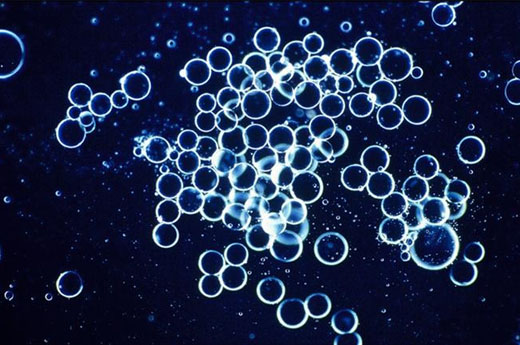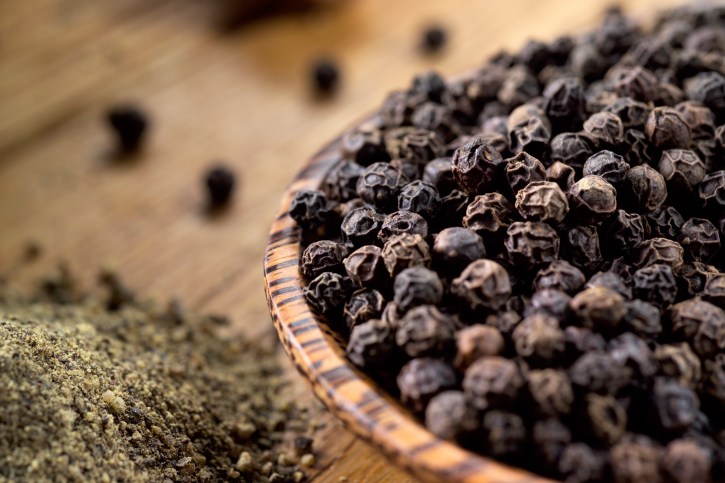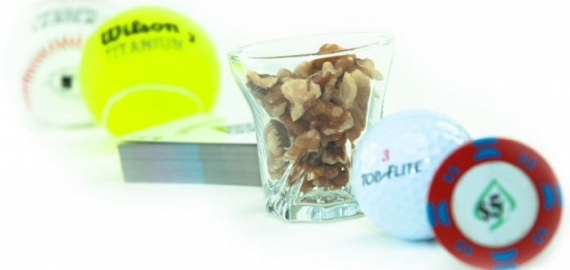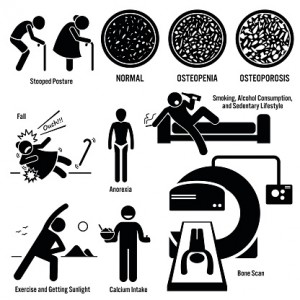Fat Facts

Human fat cells, photo by Dr. Peeke
by guest blogger Pam Peeke, MD, MPH, FACP, best-selling author and expert on health, fitness, and nutrition
While a research scientist at the National Institutes of Health, I became known as the "fat doctor," a title I held with great pride. My work entailed tag-teaming with surgeons in the operating room and harvesting human fat cells during surgery. Bless every one of the wonderful research subjects who agreed--rather happily, I might add!--to let me remove a small sample of fat from various parts of their bodies, both deep inside (deep in the belly) and just under the skin (subcutaneous). Next, these gleaming gelatinous globs of fat were carefully placed in the portable liquid nitrogen cylinder that accompanied me everywhere. Then it was off to my lab to prep the specimens for our experiments.
Hunched over my lab bench, I would marvel at the beauty, power, and mystery of the fat cells, or adipocytes (adip=fat, cyte=cell), I beheld under my specialized microscopes. It also occurred to me that most people probably don't have a clue as to what fat cells do other than inspire torment and angst when they're trying to crowbar themselves into a pair of jeans.
So how about a quick primer on all things fat, so that you can, as I have, learn to appreciate, not disparage, these incredible and integral parts of our anatomy? I'm only talking about fat as a physical entity and won't be speaking to any issues related to why people are under- or overweight. This is just an anatomy lesson!
So here's a brief summary of fat facts, starting with the two types we have.
1. Brown Fat.
This fat is composed of several small lipid (fat) droplets and a large number of iron-containing mitochondria (the cell's heat-burning engine). The iron, along with lots of blood tiny blood vessels, gives this fat its brownish appearance. Brown fat is usually found in the front and back of the neck and upper back.
The purpose of brown fat is to burn calories in order to generate heat. That's why brown fat is often referred to as the "good" fat, since it helps us burn, not store, calories. Brown fat is derived from muscle tissue and is found primarily in hibernating animals and newborns. After life as an infant, the quantity of brown fat significantly decreases. Adults who have comparatively more brown fat tend to be younger and slender and have normal blood sugar levels.
You generate brown fat by: exercising, which can convert white-yellow fat to a more metabolically active brown fat; getting enough high-quality sleep, as proper melatonin production influences the production of brown fat; and exposing yourself to the cold regularly, such as exercising outdoors in the wintertime or in a cold room. Lowering the temperature in your living and working spaces is another tip.
Bottom line: You want as much of this type of fat as possible. Bring on the brown!
2. White Fat.
This type of fat is composed of a single lipid droplet and has far less mitochondria and blood vessels, thus resulting in its lighter white or yellow appearance. White fat is the predominant form of fat in the body, originating from connective tissue.
White fat has many purposes. It provides the largest energy reserve in the body. It's a thermal insulator and cushion for our internal organs, and cushions during external interactions with our environment (that's code for a soft landing when we fall on our behind!). It is a major endocrine organ, producing one form of estrogen as well as leptin, a hormone that helps regulate appetite and hunger. It's also got receptors for insulin, growth hormone, adrenaline, and cortisol (stress hormone). So, it's a myth that fat cells just sit there and do nothing all day long!
White fat is found, oh heck, you know where it's found. Just look in the mirror! In women, excess fat accumulates around the hips, thighs, buttocks, and breasts until perimenopause (the 40s), when fat is redistributed to the abdomen as well. Men tend to gather excess fat primarily in the belly region most of their lives.
An excess of white fat inside the belly (visceral fat) is associated with metabolic syndrome--a group of symptoms that signal an increased risk for heart disease, diabetes, and cancer. Location of body fat really counts!
Excess white fat throughout the body is associated with an increased risk of breast, colon, esophageal, gall bladder, and pancreatic cancer. It's also associated with sleep apnea, and physical disabilities such as knee arthritis.
Here's how much white fat a "normal-weight" person would carry throughout a lifetime: Men's body fat range is 15 to 25 percent; women's is 15 to 30 percent. Your generic 154-pound person would carry about 20 pounds of fat. One pound of stored fat contains roughly 4,000 calories, so 20 pounds has 80,000 calories of energy storage. If you required 2,000 calories to live per day, you'd last about 40 days on a desert island. These numbers aren't meant to be perfect or exact, but instead, give you a broad, general idea.
You generate white fat by: consuming too many calories and expending too few calories.
Bottom line: As a species, white fat is very important to our survival. It's a matter of how much and where it's located. You want to control your visceral fat level (keeping your waist circumference to less than 35 inches if you're a woman, and to less than 40 inches if you're a man) and keep your total body fat within the normal ranges for each gender.
Does white fat interact with brown fat? You better believe it. New research shows that when people overeat, they not only increase their total amount of white fat, but the overconsumption results in their brown fat becoming dysfunctional and thus unable to burn calories.
All right, the lesson is over, and now you're locked and loaded with new knowledge about all things adipose tissue.
Starting today, make it a point to achieve two major goals: Optimize your brown fat function and manage your white fat load--by doing precisely the same thing. That is, eat whole foods in moderation, stay active, practice stress resilience, and lead a mindful lifestyle. You'll keep those mitochondria hummin' while your health and wellness skyrocket!
 Pamela Peeke, MD, MPH, FACP, is a Pew Scholar in nutrition and metabolism, assistant professor of medicine at the University of Maryland, and a fellow of the American College of Physicians. A triathlete and mountaineer, she is known as "the doc who walks the talk," living what she's learned as an expert in health, fitness, and nutrition. Dr. Peeke is featured as one of America's leading women physicians in the National Institutes of Health Changing Face of Medicine exhibit at the National Library of Medicine. Her current research at the University of Maryland centers on the connection between meditation and overeating. She is the author of many best-selling books, including Fight Fat after Forty. Her new book is the New York Times best-seller The Hunger Fix.
Pamela Peeke, MD, MPH, FACP, is a Pew Scholar in nutrition and metabolism, assistant professor of medicine at the University of Maryland, and a fellow of the American College of Physicians. A triathlete and mountaineer, she is known as "the doc who walks the talk," living what she's learned as an expert in health, fitness, and nutrition. Dr. Peeke is featured as one of America's leading women physicians in the National Institutes of Health Changing Face of Medicine exhibit at the National Library of Medicine. Her current research at the University of Maryland centers on the connection between meditation and overeating. She is the author of many best-selling books, including Fight Fat after Forty. Her new book is the New York Times best-seller The Hunger Fix.
-
Lose Weight with Some Friends
Once you have sat down and had a little
-
Low Blood Sugar: Hypoglycemia
Low blood sugar Hypoglycemia is a serious condition in which a per
-
Manage Your Weight Safely And Effectively With These Tips
Many people want to lose weight. No matter how enthusiastic the
-
8 Ways To Drop Weight Now
In this world that we live in there are
-
Calorie Counter and Why You Should Not Trust Them
Calorie counters are used in nearly all
-
Weight Loss Tips To Losing Those Unwanted Pounds Quickly
What Are The Weight Loss Tips To Losing Those Unwanted Pounds Quick
- DON'T MISS
- Dieting with pleasure.
- 5 Fat-Burning Herbs & Spices
- Hoodia Gordonii - Amazing Weight Loss Results!
- The Healthy Food Halo
- How To Get In Shape On A Budget
- Health-Care vs. Self-Care
- Can I Lose My Baby Weight?
- Cheap Equipment For Fitness Training
- Losing Weight In 2016, But Where Do You Begin
- The Secret To Losing Weight




